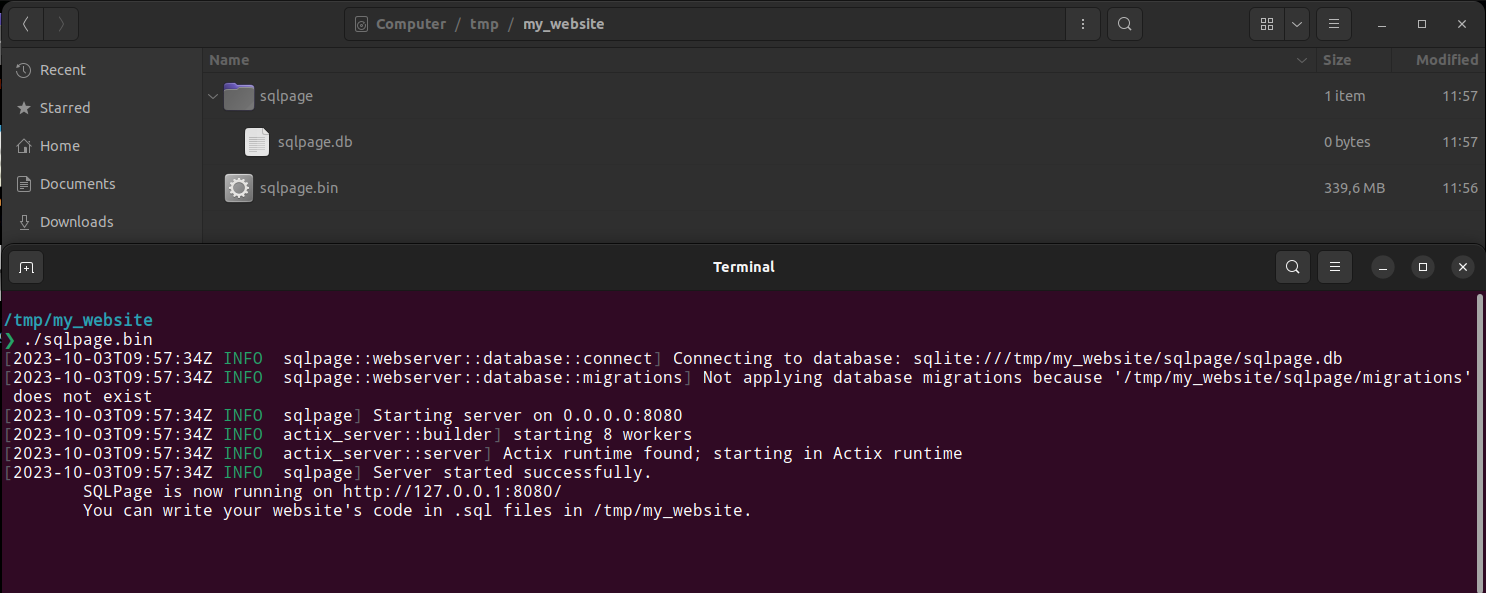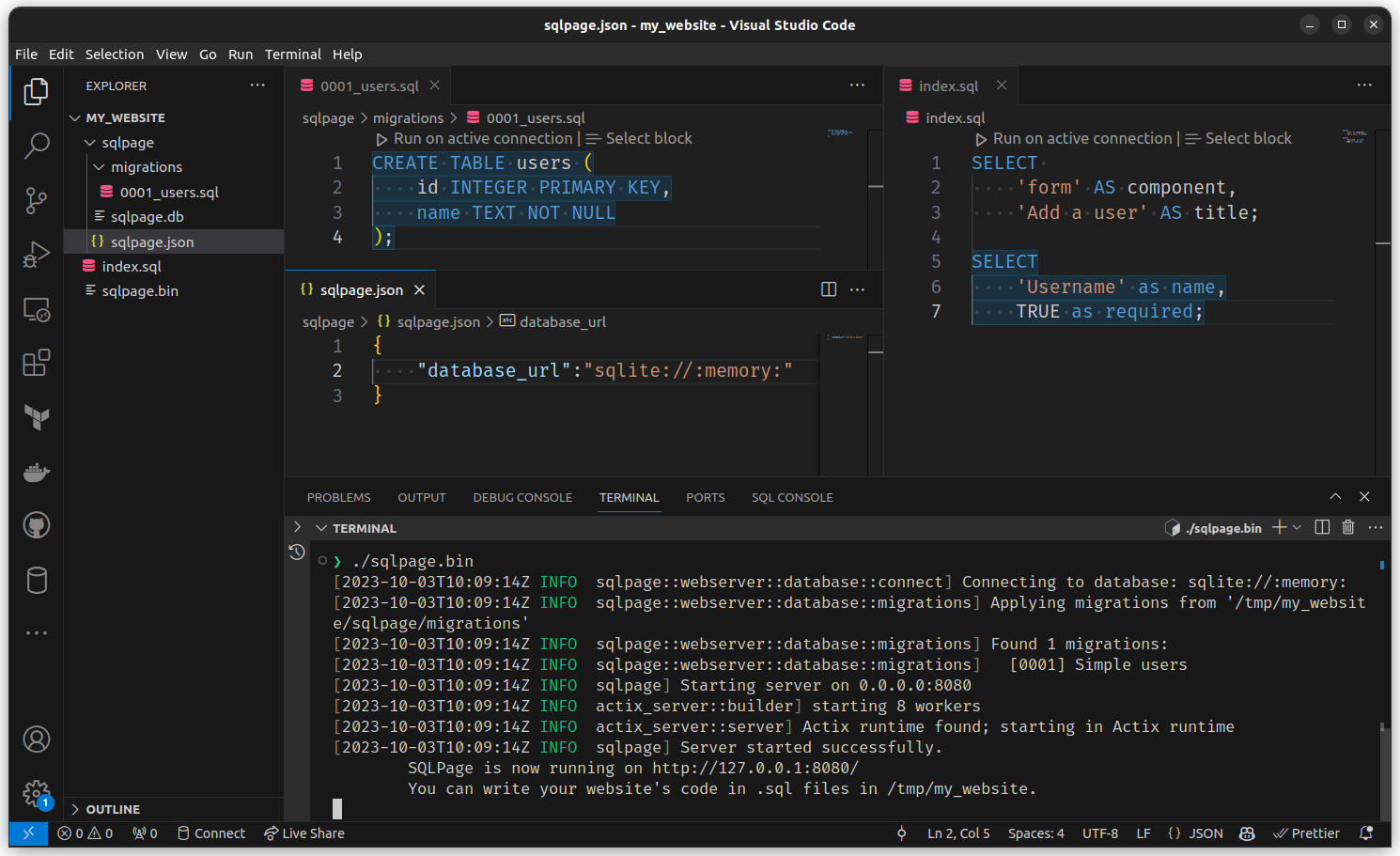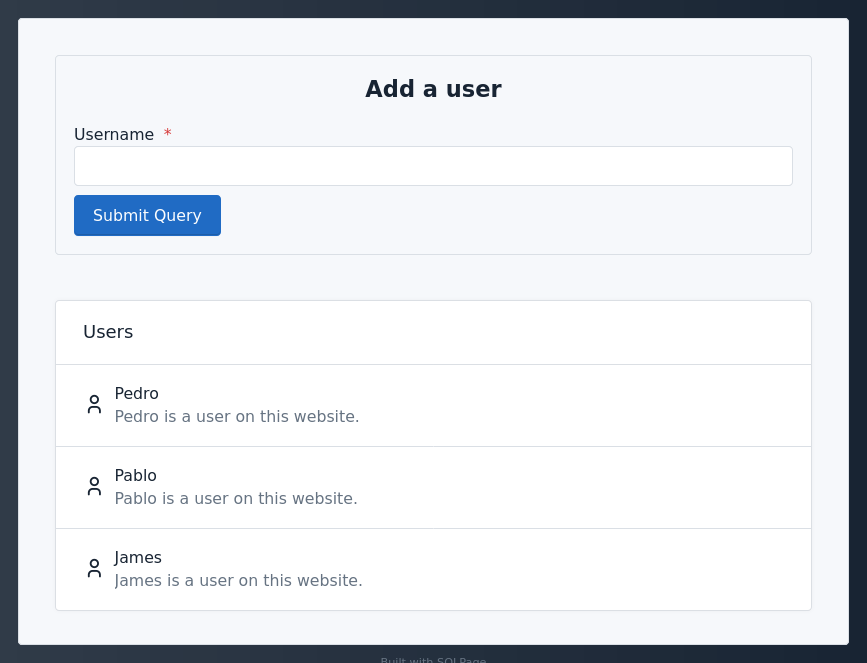Your first SQL Website

Afraid of the setup ? Do it the easy way !
You don’t want to have anything to do with scary hacker things ? You can use a preconfigured SQLPage hosted on our servers, and never have to configure a server yourself.
Do you prefer videos ?
I made a video to introduce you to SQLPage. You can watch it on YouTube. The video covers everything from the underlying technology to the philosophy behind SQLPage to the actual steps to create your first website.
Download SQLPage: the SQL website framework
SQLPage is a small executable file that will take requests to your website, execute the SQL files you write, and render the database responses as nice web pages.
Download the latest SQLPage for your operating system.
In the release assets section, you will find files named sqlpage-windows.zip, sqlpage-linux.tgz, and sqlpage-macos.tgz.
Download the one that corresponds to your operating system, and extract the executable file from the archive.
Note: Advanced users can alternatively install SQLPage using docker, brew, nix, scoop, or cargo.
Building your website locally
Create a folder on your computer where you will store all contents related to your sql website. In the rest of this tutorial, we will call this folder the root folder of your website.
Open the file you downloaded above, and place sqlpage.bin (if you are on linux or Mac OS)
or sqlpage.exe at the root of the folder.
Then launch the sqlpage.bin executable file you just downloaded in a terminal from this folder.

You should see a message in your terminal that includes the sentence accessible from the network, and locally on http://localhost:8080
You can open your website locally by visiting http://localhost:8080
Your website’s first SQL file
In the root folder of your SQLPage website, create a new SQL file called index.sql.
Open it in a text editor that supports SQL syntax highlighting (I recommend VSCode).
The index.sql file will be executed every time a visitor opens your website's home page.
You can use it to retrieve data from your database and define how it should be displayed to your visitors.
As an example, let's start with a simple index.sql that displays a list of popular websites:
SELECT 'list' AS component, 'Popular websites' AS title;
SELECT 'Hello' AS title, 'world' AS description, 'https://wikipedia.org' AS link;
The first line of the file defines the component that will be used to display the data, and properties of that component.
In this case, we use the list component to display a list of items.
The second line defines the data that will populate the component.
All the components you can use and their properties are documented in SQLPage's online documentation.
Your database schema
If you already have a database populated with data, or if you intend to use other tools to manage your database structure, you can skip this section.
The database schema for your SQLPage website
can be defined using SQL scripts located in the
sqlpage/migrations subdirectory of your website's root folder.
For our first website, let's create a file located in sqlpage/migrations/0001_create_users_table.sql with the following contents:
CREATE TABLE users (
id INTEGER PRIMARY KEY,
name TEXT NOT NULL
);
Please read our introduction to database migrations to learn how to maintain your database schema in the long term.
Note: The migration system is not supported on Microsoft SQL Server databases. If you are using a SQL Server database, you should create your tables using a different tool, such as SQL Server Management Studio.
Connect to a custom database
By default, SQLPage uses a SQLite database stored in a file named sqlpage.db
in the sqlpage configuration folder.
You can change this by creating a file named sqlpage.json in a folder called sqlpage.
So, if your website's root folder is /my_website, you should create a file at /my_website/sqlpage/sqlpage.json.
Here is an example sqlpage.json file:
{ "database_url": "sqlite://:memory:" }
This will tell SQLPage to use an in-memory SQLite database instead of the default file-based database. All your data will be lost when you stop the SQLPage server, but it is useful for quickly testing and iterating on your database schema.
Later, when you want to deploy your website online, you can switch back to a persisted database like
- a SQLite file with
sqlite://your-database-file.db(see options), - a PostgreSQL-compatible server with
postgres://user:password@host/database(see options), - a MySQL-compatible server with
mysql://user:password@host/database(see options), - a Microsoft SQL Server with
mssql://user:password@host/database(see options, note about named instances),
If user or password contains special characters, you should percent-encode them.
For instance, a SQL Server database named db running on localhost port 1433 with the username funny:user and the password p@ssw0rd would be represented as mssql://funny%3Auser:p%40ssw0rd@localhost:1433/db.
For more information about the properties that can be set in sqlpage.json, see SQLPage's configuration documentation

Use parameterized SQL queries to let users interact with your database
Displaying a form
Let’s create a form to let our users insert data into our database. Add the following code to your index.sql file:
SELECT 'form' AS component, 'Add a user' AS title;
SELECT 'Username' as name, TRUE as required;
The snippet above uses the form component to display a form on your website.
Handling form submission
Nothing happens when you submit the form at the moment. Let’s fix that. Add the following below the previous code:
INSERT INTO users (name)
SELECT :Username
WHERE :Username IS NOT NULL;
The snippet above uses an INSERT INTO SELECT SQL statement to
safely insert a new row into the users table when the form is submitted.
It uses a WHERE clause to make sure that the INSERT statement is only executed when the :Username parameter is present.
The :Username parameter is set to NULL when you initially load the page, and then SQLPage automatically sets it to the value
from the text field when the user submits the form.
There are two types of parameters you can use in your SQL queries:
:ParameterNameis a POST parameter. It is set to the value of the field with the correspondingnamein a form. If no form was submitted, it is set toNULL.$ParameterNameworks the same as:ParameterName, but it can also be set through a query parameter in the URL. If you add?x=1&y=2to the end of the URL of your page,$xwill be set to the string'1'and$ywill be set to the string'2'. If a query parameter was not provided, it is set toNULL.
Displaying contents from the database
Now, users are present in our database, but we can’t see them. Let’s fix that by adding the following code to our index.sql file:
SELECT 'list' AS component, 'Users' AS title;
SELECT name AS title, CONCAT(name, ' is a user on this website.') as description FROM users;
Your first SQLPage website is ready!
You can view the full source code for this example on Github
Here is a screenshot of the final result:

To go further, have a look at the examples section of our Github repository.
Deploy your SQLPage website online
If you want to make your SQLPage website accessible online for everyone to browse, you can deploy it to a VPS (Virtual Private Server). To get started, sign up for a VPS provider of your choice. Some popular options include: AWS EC2, DigitalOcean, Linode, Hetzner.
Once you have signed up with a VPS provider, create a new VPS instance. The steps may vary depending on the provider, but generally, you will need to:
- Choose the appropriate server type and specifications. SQLPage uses very few resources, so you should be fine with the cheaper options.
- Set up SSH access.
Once your VPS instance is up and running, you can connect to it using SSH. The provider should provide you with the necessary instructions on how to connect via SSH.
For example, if you are using a Linux or macOS terminal, you can use the following command:
ssh username@your-vps-ip-address
Transfer your SQLPage website files to the VPS
For example, if you are using SCP, you can run the following command from your local computer, replacing the placeholders with your own information:
scp -r /path/to/your/sqlpage/folder username@your-vps-ip-address:/path/to/destination
Run SQLPage on the server
Once your SQLPage website files are on the server, you can run SQLPage on the server, just like you did on your local computer. Download the SQLPage for linux binary and upload it to your server.
Then, run the following command on your server:
./sqlpage
To access your website, enter the address of your VPS in your address bar, followed by the port on which SQLPage runs. For instance: http://123.123.123.123:8080.
For production use, you should:
- run SQLPage as a service, using a tool like docker or systemd.
- use a reverse proxy like nginx to improve security and performance, or to configure multiple websites on the same server.